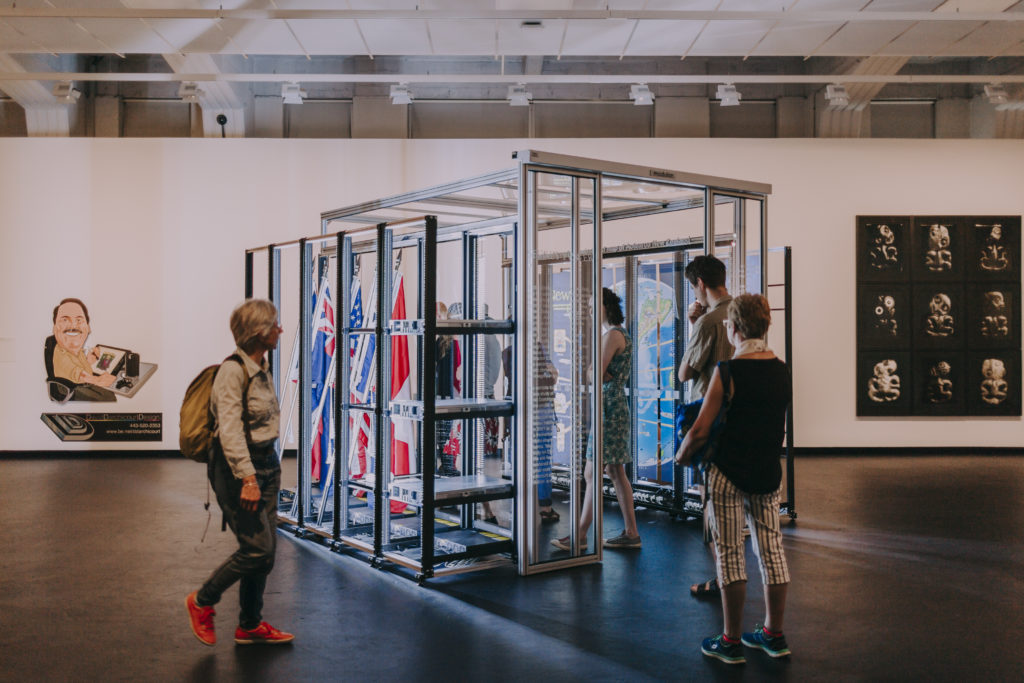(with Aaron Lister and Moya Lawson) This Is New Zealand, ex. cat. (Wellington: City Gallery Wellington, 2018).
First, a word from the curators …
Teasing out connections between images, ideology, and identity, our exhibition This Is New Zealand reflects on who we thought we were, who we think we are. Taking a critical look at stories we’ve told ourselves and others, it asks: Who and what have been included and excluded? And who is this mythical ‘we’?
This Is New Zealand emerged out of our thinking about New Zealand’s participation in the Venice Biennale. New Zealand has been going to the Biennale since 2001, and it looms large for our art scene. The Biennale is the world’s largest, most important, and longest-running regular contemporary-art mega-show, and our participation declares our desire to be ‘international’, to be part of the wider art discussion. However, some of the artists we have sent to Venice have taken it as an opportunity to tackle old questions of national identity, riffing on the Biennale’s old-school national-pavilion structure. Our show includes three examples from Venice. Michael Stevenson’s 2003 project This Is the Trekka looks like a belated trade display for a New Zealand car. Michael Parekōwhai’s carved piano, He Kōrero Pūrākau mō te Awanui o te Motu: Story of a New Zealand River, was the centrepiece of his 2011 show On First Looking into Chapman’s Homer. And there’s a component from Simon Denny’s 2015 show, Secret Power, which presented his inquiry into the Snowden leaks and New Zealand’s involvement in the Five Eyes alliance as an official state-sanctioned project.
The Venice Biennale relates to the tradition of World’s Fairs and Expos, which typically present the world nation by nation, each paying its own way. So, our next thought was to place our three New Zealand Venice works into conversation with works that have been made to represent New Zealand in such shows and in other official diplomatic contexts. These include two New Zealand history paintings that Marcus King made for the 1939 New York World’s Fair (one of which has become the most famous image of the signing of the Treaty of Waitangi). There’s John Drawbridge’s abstracted New Zealand landscape mural and Inia Te Wiata’s Pouihi, made for New Zealand House in London in the 1960s. And there are works from New Zealand’s pavilion at Expo ’70 in Osaka: Hugh Macdonald’s spectacular three-screen film (which gives our show its name) and Green Are the Islands, a mass performance involving the New Zealand Ballet, Paratene Matchitt, Douglas Lilburn, and others. We’ve also included two suites of photographs—by Fiona Pardington and Michael Parekōwhai—that our Government gave to the Musée du Quai Branly, Paris, in 2006.
To round out the show, there are research-based projects exploring national iconography by Simon Denny, Gavin Hipkins, Bronwyn Holloway-Smith, and Emil McAvoy. And, to further fudge the distinction between art and culture, we’ve added in early New Zealand tourism posters, and some TV ads and films. Plus, in Civic Square, we’re flying our triumphant flag alongside its recent challengers.
This Is New Zealand scratches the surface to explore some of the ways that art and artists have addressed the perennial theme of national identity. It tracks the way some images have become archetypal, echoing through time, entrenching the national-image repertoire. The use of Māori and Māori imagery in the myriad ways New Zealand has represented itself has long been a thorny issue. This show provides an opportunity to consider where—or if—presumptuous appropriation ends and biculturalism begins. At a time when notions of what New Zealand is or can be are being debated and recalibrated as never before, our show considers the role art has played in giving visual form to abstract ideas about the nation.
Our title This Is New Zealand is rhetorical—a provocation. ‘Why no question mark?’ All our exhibits are skewed views that exclude more than they include. However, you could also say that these works, collectively, in their very exclusions and distortions, speak of tensions that define our place. Perhaps this bumpy, warts-and-all compilation of mixed messages really is New Zealand. We’ll leave that for you, our fellow citizens, to determine. Anyone for a referendum?
—Robert Leonard and Aaron Lister
